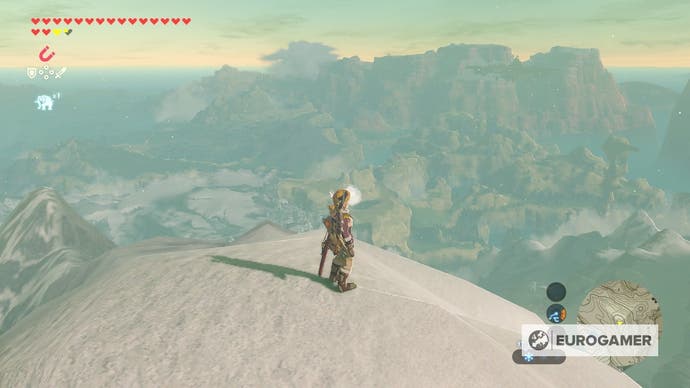Games of the Decade: The Legend of Zelda: Breath of the Wild is about a ruined world
Hey! Listen!
To mark the end of the 2010s, we're celebrating 30 games that defined the last 10 years. You can find all the articles as they're published in the Games of the Decade archive, and read about the thinking behind it in an editor's blog.
Vah Medoh was my favourite out of all the Divine Beasts in The Legend of Zelda: Breath of the Wild, because of the magnificent view it gave me of Hyrule. As the mechanical bird flew through the sky, I could see the Duelling Peaks in the distance and, below me, the vast canyons that surround the Tabantha Frontier. I was stuck by the vastness of Hyrule, bringing with it the knowledge that I still hadn't, at the time, visited every location in the game.
Breath of the Wild is constantly encouraging you to explore Hyrule - be it a falling star, the glimpse of a dragon in the distance or a new mountain to climb. It ignites a desire for exploration that sends you across a barren desert or up a perilous mountain to discover a dragon curled around its peak. Using the pictures saved within the Shiekah Slate to uncover Link's lost memories is a great combination of storytelling and environmental puzzles, coaxing you into travelling to new locations. Every cave, hilltop and river are designed to tempt you further off the beaten path, until you can't quite remember what you were doing in the first place.
It helps that Hyrule moves seamlessly from region to region; loading screens only appearing when you fast travel, enter a shrine, sleep and, sometimes, die. Your adventure never feels needlessly stilted, instead every step matters as you traverse what is by far the most beautiful rendition of Hyrule to date. Walking through the morning fog in Hyrule Field or watching the evening sun being reflected in the sea, makes Hyrule feels like a living, breathing, world. Underneath this beauty, however, there is a sense of loneliness that clings to your adventure.

You can journey for hours and never encounter another character to talk to. Villages and tiny settlements are spread out across the map, allowing you to experience the great distance lying between each one and the isolation many of the surviving citizens of the Hylian Kingdom live in. Many of the areas you explore, however, are completely devoid of any signs of civilised life; either because you're wandering the depths of the wilderness or due to destruction brought upon the country by the Guardians, which still roam the landscape. When you do discover a ruin, it might be a reminder of a previous game - the crumbling ruins of Lon Lon Ranch or the Forgotten Temple, which feels very similar to the Sealed Temple from The Legend of Zelda: Skyward Sword.
Link helps people on his journey, even make new friends, but his only true company is a horse. There is no fairy fluttering around his shoulders, no imp hiding in his shadow or annoying owl that refuses to shut up. He's alone in Breath of the Wild and this loneliness breeds a feeling of emptiness, but it's not an emptiness created by a lack of game content. It's an emptiness born from the realisation that you are travelling a ruined kingdom teetering on the edge of vanishing completely.
When you stand on a hill or mountain top in Breath of the Wild, your eyes are often drawn to Hyrule Castle; the former crown jewel of the kingdom, now inhabited by the evil that brought out its destruction. Link's quest in Breath of the Wild isn't just to save Zelda, it's to rescue the entire kingdom from the threat of being lost to time completely.
You're reminded of this when you discover the ruins of an ancient forgotten tribe, possibly called the Zonai, in the jungle region of Faron or when you help build Tarrey town; returning a tiny slither of civilisation to the nearly abandoned Akkala Highlands. When you make your final ascent through Hyrule Castle, after traversing the destroyed Hyrule Castle Town, this knowledge is unavoidable. The castle grounds are overrun with Guardians, while the castle itself has been transformed into a maze of corridors, with Malice oozing from the walls.

Despite this loneliness, hope does manage to shine through. Calamity Ganon is defeated on the plains of Hyrule Field, as if to show both the people of Hyrule, and the country itself, that they've finally been freed of the evil polluting their home. The game's true ending emphasises this sense of hope, promising that the kingdom can and will be rebuilt.
Breath of the Wild's Hyrule isn't just impressive because of the sheer scale and diversity of its landscapes, but in how these are used to subtly tell the story of both the kingdom and the people that inhabit it. We barely have an idea about what the sequel might be like, but its world will certainly have to be something special to surpass this kingdom of Hyrule.









